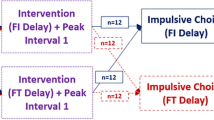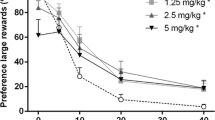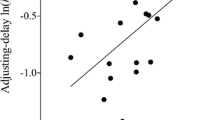Abstract
Impulsive choice is related to substance use disorders, obesity, and other behaviors that negatively impact human health. Reducing impulsive choice may prove beneficial in ameliorating these maladaptive behaviors. Preclinical research in rats indicates that one reliable method for producing large and lasting reductions in impulsive choice is delay-exposure (DE) training. In all six of the prior DE-training experiments, rats were given extensive experience (~ 120 training sessions) with a delayed reinforcement contingency. The present experiment evaluated if similar large and lasting reductions in impulsive choice could be achieved with less training. The duration of DE training between groups of male Wistar rats was 0 sessions (training ended after a lever-pressing acquisition criterion was met), 30, 60, or 120 sessions. Comparison groups were given the same durations of training with immediate reinforcement. A post-training assessment of impulsive choice was completed using an increasing-delay procedure. For rats assigned to the 60-session condition, impulsive choice was reassessed at a 120-day follow-up. DE training reduced impulsive choice but, contrary to expectation, reductions in impulsive choice did not increase with DE-training duration (no significant training-duration by group interaction). Importantly, 60 sessions of DE training produced reductions in impulsive choice that were comparable to prior published findings and this effect remained significant at the 120-day follow-up. Procedural elements that may be responsible for the DE-training effect, and how they could be improved in future experiments, are discussed.



Similar content being viewed by others
Availability of data and material
Data are available via the Open Science Framework and can be accessed via the following https://doi.org/10.17605/OSF.IO/C7BAM..
References
Alessi S, Petry N (2003) Pathological gambling severity is associated with impulsivity in a delay discounting procedure. Behav Process 64:345–354. https://doi.org/10.1016/S0376-6357(03)00150-5
Amlung M, Petker T, Jackson J et al (2016) Steep discounting of delayed monetary and food rewards in obesity: a meta-analysis. Psychol Med 46:2423–2434. https://doi.org/10.1017/S0033291716000866
Amlung M, Vedelago L, Acker J et al (2017) Steep delay discounting and addictive behavior: a meta-analysis of continuous associations. Addiction 112:51–62. https://doi.org/10.1111/add.13535
Bailey C, Peterson JR, Schnegelsiepen A et al (2018) Durability and generalizability of time-based intervention effects on impulsive choice in rats. Behav Process 152:54–62. https://doi.org/10.1016/j.beproc.2018.03.003
Balsam PD, Gallistel CR (2009) Temporal maps and informativeness in associative learning. Trends Neurosci 32:73–78. https://doi.org/10.1016/J.TINS.2008.10.004
Barrett TS, Brignone E (2017) Furniture for quantitative scientists. R J 9:142–148
Benjamini Y, Hochberg Y (1995) Controlling the false discovery rate: a practical and powerful approach to multiple testing. J R Stat Soc B 289–300
Bickel WK, Jarmolowicz DP, Mueller ET et al (2012) Excessive discounting of delayed reinforcers as a trans-disease process contributing to addiction and other disease-related vulnerabilities: emerging evidence. Pharmacol Ther 134:287–297. https://doi.org/10.1016/J.PHARMTHERA.2012.02.004
Bickel WK, Athamneh LN, Basso JC et al (2019) Excessive discounting of delayed reinforcers as a trans-disease process: update on the state of the science. Curr Opin Psychol 30:59–64. https://doi.org/10.1016/J.COPSYC.2019.01.005
Chesson HW, Leichliter JS, Zimet GD et al (2006) Discount rates and risky sexual behaviors among teenagers and young adults. J Risk Uncertain 32:217–230. https://doi.org/10.1007/s11166-006-9520-1
Cribari-Neto F, Zeileis A (2009) Beta regression in R. Department of Statistics and Mathematics, Vienna
Doremus-Fitzwater TL, Barreto M, Spear LP (2012) Age-related differences in impulsivity among adolescent and adult Sprague-Dawley rats. Behav Neurosci. https://doi.org/10.1037/a0029697
Evenden JL (1999) Varieties of impulsivity. Psychopharmacology 146:348–361. https://doi.org/10.1007/PL00005481
Evenden JL, Ryan CN (1996) The pharmacology of impulsive behaviour in rats: the effects of drugs on response choice with varying delays of reinforcement. Psychopharmacology 128:161–170. https://doi.org/10.1007/s002130050121
Fox J, Weisberg S (2011) An R companion to applied regression, 2nd edn. SAGE Publications, Thousand Oaks
Gallistel CR, Papachristos EB (2020) Number and time in acquisition, extinction and recovery. J Exp Anal Behav 113:15–36. https://doi.org/10.1002/jeab.571
Gibbon J, Baldock MD, Locurto C et al (1977) Trial and intertrial durations in autoshaping. J Exp Psychol Anim Behav Process 3:264–284
Gray JC, MacKillop J (2015) Impulsive delayed reward discounting as a genetically-influenced target for drug abuse prevention: a critical evaluation. Front Psychol. https://doi.org/10.3389/fpsyg.2015.01104
Green L, Myerson J, Shah AK et al (2007) Do adjusting-amount and adjusting-delay procedures produce equivalent estimates of subjective value in pigeons? J Exp Anal Behav 87:337–347. https://doi.org/10.1901/jeab.2007.37-06
Helms CM, Reeves JM, Mitchell SH (2006) Impact of strain and d-amphetamine on impulsivity (delay discounting) in inbred mice. Psychopharmacology 188:144–151. https://doi.org/10.1007/s00213-006-0478-0
Killeen PR (2011) Models of trace decay, eligibility for reinforcement, and delay of reinforcement gradients, from exponential to hyperboloid. Behav Process 87:57–63. https://doi.org/10.1016/j.beproc.2010.12.016
Koffarnus MN, Jarmolowicz DP, Mueller ET, Bickel WK (2013) Changing delay discounting in the light of the competing neurobehavioral decision systems theory: a review. J Exp Anal Behav 99:32–57. https://doi.org/10.1002/jeab.2
Lenth RV (2016) Least-squares means: the R package lsmeans. J Stat Softw 69:1–33
Logue AW, Mazur JE (1981) Maintenance of self-control acquired through a fading procedure: follow-up on Mazur and Logue (1978). Behav Anal Lett 1:131–137
MacKillop J, Amlung MT, Few LR et al (2011) Delayed reward discounting and addictive behavior: a meta-analysis. Psychopharmacology 216:305–321. https://doi.org/10.1007/s00213-011-2229-0
Madden GJ, Bickel WK, Jacobs EA (1999) Discounting of delayed rewards in opioid-dependent outpatients: exponential or hyperbolic discounting functions? Exp Clin Psychopharmacol 7:284–293. https://doi.org/10.1037/1064-1297.7.3.284
Mazur JE (1987) An adjusting procedure for studying delayed reinforcement. In: Commons ML, Mazur JE, Nevin JA, Rachlin H (eds) Quantitative analysis of behavior: the effect of delay and of intervening events on reinforcement value. Lawrence Erlbaum Associates, Hillsdale, pp 55–73
Mazur JE, Logue AW (1978) Choice in a “self-control” paradigm: effects of a fading procedure. J Exp Anal Behav 30:11–17. https://doi.org/10.1901/jeab.1978.30-11
Myerson J, Green L, Warusawitharana M (2001) Area under the curve as a measure of discounting. J Exp Anal Behav 76:235–243. https://doi.org/10.1901/jeab.2001.76-235
Odum AL, Madden GJ, Badger GJ, Bickel WK (2000) Needle sharing in opioid-dependent outpatients: psychological processes underlying risk. Drug Alcohol Depend 60:259–266. https://doi.org/10.1016/S0376-8716(00)00111-3
Olds JL, Golski S, Mcphie DL et al (1990) Discrimination learning alters the distribution of protein kinase C in the hippocampus of rats. J Neurosci 10:3707–3713
Peck S, Rung JM, Hinnenkamp JE, Madden GJ (2019) Reducing impulsive choice: VI. Delay-exposure training reduces aversion to delay-signaling stimuli. Psychol Addict Behav 5:10. https://doi.org/10.1037/adb0000495
Petry NM (2001) Pathological gamblers, with and without substance abuse disorders, discount delayed rewards at high rates. J Abnorm Psychol 110:482–487. https://doi.org/10.1037/0021-843X.110.3.482
Pinkston JW, Lamb RJ (2011) Delay discounting in C57BL/6J and DBA/2J mice: adolescent-limited and life-persistent patterns of impulsivity. Behav Neurosci. https://doi.org/10.1037/a0022919
R Core Team (2013) R: A language and environment for statistical computing R foundation for statistical computing, Vienna, Austria. http://www.R-project.org/
Rachlin H, Raineri A, Cross D (1991) Subjective probability and delay. J Exp Anal Behav 55:233–244. https://doi.org/10.1901/jeab.1991.55-233
Renda CR, Madden GJ (2016) Impulsive choice and pre-exposure to delays: III. Four-month test-retest outcomes in male wistar rats. Behav Process. https://doi.org/10.1016/j.beproc.2016.03.014
Renda CR, Rung JM, Hinnenkamp JE et al (2018) Impulsive choice and pre-exposure to delays: IV. Effects of delay- and immediacy-exposure training relative to maturational changes in impulsivity. J Exp Anal Behav. https://doi.org/10.1002/jeab.432
Rung JM, Madden GJ (2018) Experimental reductions of delay discounting and impulsive choice: a systematic review and meta-analysis. J Exp Psychol Gen 147:1349
Rung JM, Buhusi CV, Madden GJ (2018) Reducing impulsive choice: V. The role of timing in delay-exposure training. Behav Process 157:557–561. https://doi.org/10.1016/j.beproc.2018.04.018
Scholten H, Scheres A, de Water E et al (2019) Behavioral trainings and manipulations to reduce delay discounting: a systematic review. Psychon Bull Rev 26:1803–1849
Schweitzer J, Sulzer-Azaroff B (1988) Self-control: teaching tolerance for delay in implulsive children. J Exp Anal Behav 50:173–186
Shahan TA, Cunningham P (2015) Conditioned reinforcement and information theory reconsidered. J Exp Anal Behav 103:405–418. https://doi.org/10.1002/jeab.142
Smith T, Panfil K, Bailey C, Kirkpatrick K (2019) Cognitive and behavioral training interventions to promote self-control. J Exp Psychol Anim Learn Cogn 45:259–279. https://doi.org/10.1037/xan0000208
Stein JS, Madden GJ (2013) Delay discounting and drug abuse: empirical, conceptual, and methodological considerations. In: MacKillop J, de Wit H (eds) The wiley-blackwell handbook of addiction psychopharmacology. Wiley Blackwell, pp 165–208
Stein JS, Pinkston JW, Brewer AT et al (2012) Delay discounting in Lewis and Fischer 344 rats: steady-state and rapid-determination adjusting-amount procedures. J Exp Anal Behav. https://doi.org/10.1901/jeab.2012.97-305
Stein JS, Johnson PS, Renda C et al (2013) Early and prolonged exposure to reward delay: effects on impulsive choice and alcohol self-administration in male rats. Exp Clin Psychopharmacol. https://doi.org/10.1037/a0031245
Stein JS, Renda CR, Hinnenkamp JE, Madden GJ (2015) Impulsive choice, alcohol consumption, and pre-exposure to delayed rewards: II Potential mechanisms. J Exp Anal Behav. https://doi.org/10.1002/jeab.116
Vedelago L, Amlung M, Morris V et al (2019) Technological advances in the assessment of impulse control in offenders: a systematic review. Behav Sci Law. https://doi.org/10.1002/bsl.2420
Volkow ND, Baler RD (2015) NOW vs LATER brain circuits: implications for obesity and addiction. Trends Neurosci 38:345–352. https://doi.org/10.1016/J.TINS.2015.04.002
Williams BA (1994) Conditioned reinforcement: experimental and theoretical issues. Behav Anal 17:261–285. https://doi.org/10.1007/BF03392675
Funding
This research was supported by grants from the National Institute of Health (NIH): R21 DA042174-01 and R03 DA044927-01, awarded to the last author (G. J. Madden). Jillian M. Rung’s time was partially supported by the University of Florida Substance Abuse Training Center in Public Health from the National Institute on Drug Abuse under award number T32 DA035167. The content is solely the responsibility of the author(s) and does not necessarily represent the official views of the NIH.
Author information
Authors and Affiliations
Contributions
All authors have contributed substantively to this article and have read and approved this final manuscript.
Corresponding author
Ethics declarations
Conflict of interest
None of the authors have any real or potential conflict(s) of interest, including financial, personal, or other relationships with organizations or pharmaceutical/biomedical companies that may inappropriately influence the research and interpretation of the findings.
Ethics approval
Procedures were conducted in accordance with protocols approved by the Institution of Animal Care and Use Committee at Utah State University (IACUC protocols 2602 and 2232).
Consent for publication
Portions of this manuscript were previously reported in partial fulfillment of the degree of Doctor of Philosophy awarded to the first author (C. R. Renda). Portions of the data were presented at the annual meeting of the Association for Behavior Analysis International in Denver, CO (May 2017). Some of the data have been previously published (Peck et al. 2019).
Code availability
Code for conducting statistical analyses presented herein are available alongside the data via the doi listed above.
Additional information
Publisher's Note
Springer Nature remains neutral with regard to jurisdictional claims in published maps and institutional affiliations.
Rights and permissions
About this article
Cite this article
Renda, C.R., Rung, J.M., Peck, S. et al. Reducing impulsive choice VII: effects of duration of delay-exposure training. Anim Cogn 24, 11–21 (2021). https://doi.org/10.1007/s10071-020-01412-0
Received:
Revised:
Accepted:
Published:
Issue Date:
DOI: https://doi.org/10.1007/s10071-020-01412-0




